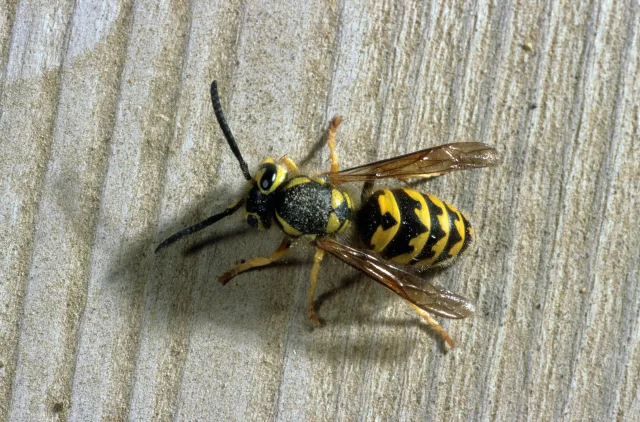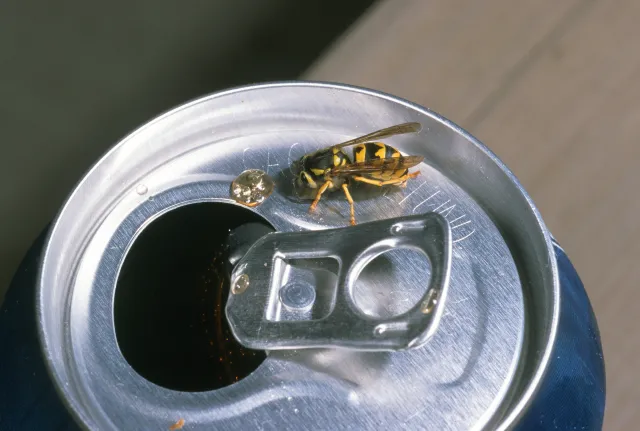It’s that time of year when yellowjackets can ruin your outdoor picnic or gathering. Yellowjacket wasps prey on other insects and scavenge on human food and garbage. Keep reading to learn what they are looking for and ways to get rid of them!
Yellowjackets, sometimes called “meat bees,” defend their nests, as do other social wasps and bees. They are more likely to sting if disturbed while foraging. Stings hurt and cause short-term injury, but some people suffer severe allergic responses. Prevent stings by avoiding wasps and removing food sources. Trapping or nest treatment can reduce yellowjacket populations.

Is it a yellowjacket or something else?
- Yellowjackets are 1⁄2 to 1 inch long with jagged bright yellow and black stripes. Their narrow “waists” are barely visible. Unlike other common wasps, yellowjackets scavenge on food. They nest in holes in the ground, inside wall cavities, or in hanging nests totally enclosed in gray paper with a single entrance.
- Paper wasps have long slender waists, build paper nests with many open cells under eaves, and are rarely aggressive.
- Mud daubers are dark-colored and thread-waisted. They build small, hard mud nests and rarely sting.
- Honey bees are less brightly striped than yellowjackets and have more hair. They usually aren’t attracted to food, although they may go to sweets. Honey bees are unlikely to sting unless trapped or stepped on. They often nest inside cavities in trees or houses.
Stay calm to avoid stings.
- If a wasp lands on you, don’t swat it or run. Wait for it to leave, or gently brush it away.
- Don’t disturb nests. Wasps flying from a hole in the ground or a building indicate a probable nest.
Remove attractive food sources.
- Keep food, including pet food, covered or indoors.
- Outdoors, cover soda cans so wasps don’t crawl in.
- Keep garbage in sealed cans and empty regularly.
- Pick up and dispose of ripe fruit.
Use traps to reduce yellowjacket numbers.
- Yellow lure traps hung along the perimeter of a property can reduce foraging of some species around patios or picnic areas.
- Homemade traps using meat bait hung on a string just above soapy water may also be used.
- Place traps away from areas where people gather, such as picnic tables.
What should you do about a nest?
- Ask your Mosquito and Vector Control District if they treat nests or locate a licensed pest control company. Nests might be far away and hard to find.
- If you choose to treat nests yourself, wear protective clothing on your body, hands, and head. Use an insecticide that shoots a long stream into the nest entrance and is labeled for treating yellowjacket nests.
- Paper wasp nests shouldn’t require treatment unless they are near people.
If you have a wasp problem and need management tips, visit the Pest Notes: Yellowjackets and Other Social Wasps. Although yellowjackets can be a nuisance, some species do prey on plant-feeding insects and nuisance flies and are considered beneficial predators.


